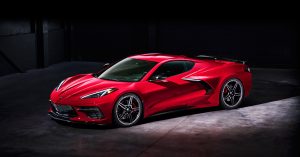I wish I’d seen Joakim Rydholm take the new Polestar 2 electric sedan around the test track in Sweden before my drive, rather than after.
The engineer, who designed the chassis and happens to be the program’s chief test driver, hammered the handsome, unassuming sedan through every turn, seeming to squeeze every pound-foot of torque from the 78-kWh battery pack and dual permanent-magnet motors. (That’s a very healthy 487 pound-feet, to be precise, complementing 408 horsepower.) Despite damp conditions, the car stayed planted and poised, but still squeaked out a few satisfying hints of back-end looseness in several turns.
By comparison, my laps around Volvo’s Hällered Proving Grounds—Polestar is Volvo’s electric-focused performance division—was a leisurely leaf-peeping tour through western Sweden. And I was going as fast as I dared on a wet, unfamiliar track while adapting to a new EV that I wrongly assumed wasn’t a track beast. Plus, Rydholm, riding shotgun, had mumbled something about a course speed limit, giving me further pause—though he seemed to thoroughly disregard it once behind the wheel himself.
“Your primary tools are the anti-roll bars, springs, and dampers,” says Polestar engineer and test driver Joakim Rydholm. “If you have head-toss on a bumpy road, you work with the anti-roll bars. Hard impacts, you work with the tires and shock absorbers.”
Courtesy of PolestarI longed for another crack at the track in the surprising little machine. But excuses aside, I learned enough from my still reasonably spirited time there and on public roads around Volvo’s HQ in Gothenburg to posit that when the Polestar 2 arrives next year, it will be a worthy competitor to the performance-oriented version of Tesla’s Model 3. Granted, the prototype I drove included the optional, $6,600 “Performance Pack,” which provides Brembo brakes, 20-inch alloy wheels, and a set of Öhlins suspension dampers that are tuned manually at each wheel, to better balance the car in the corners. “It makes the car smoother without the driver losing confidence,” Rydholm says.
Drivers uninterested in stomach-churning track expeditions will be glad to know that Polestar’s first fully electric car is a useful, family-friendly sedan. And to go with that performance, it promises a practical 275 miles of range—to be eventually validated by the EPA, of course. Rydholm and his team spent years at the proving grounds, tuning the car’s performance on the handling track I drove and the more varied “comfort track,” which simulates a host of roadway surfaces and anomalies. “Your primary tools are the anti-roll bars, springs, and dampers,” Rydholm says. “If you have head-toss on a bumpy road, you work with the anti-roll bars. Hard impacts, you work with the tires and shock absorbers.”
My own laps validated the effort put into the dynamics engineering, with the car sticking hard in the turns on the hallowed grounds of Hällered. The all-wheel-drive setup, using the front and rear motors, delivered power immediately to accelerate out of the turn and onto the next straight. On public roads, the car was smooth and quiet, with negligible wind or tire noise—especially impressive in a vehicle without an engine masking those sounds.
Those who opt for the $45,000 base version, which will come about a year after the Launch Edition debuts at $63,000, will still be able to go from 0 to 60 mph in 4.7 seconds. (Polestar hasn’t yet released the car’s top speed.) All customers will also get a water-cooled lithium-ion battery pack, developed with LG and capable of charging in just 35 minutes through a 150-kW charging station.
Even at half the Taycan’s base price, the Polestar 2 offers ride quality near to the Porsche’s standard.
Photograph: Istvan Csiszar/PolestarA clean and attractive design both inside and out caps off the package, with a bonus industry premier lurking inside: This is the first car to include Google’s Android-based infotainment system. All the vehicle systems and connectivity features—navigation, search, contacts—are accessed through Google, with wireless access included in the purchase price. Though the prototype I drove didn’t have this system fully operational yet, a stand-alone test rig I tinkered with showed a simple and elegant interface, with a single dominant screen and quick and easy access to features and controls. (GM vehicles will also offer Android-based infotainment systems in the near future.)
As the name suggests, this is the second vehicle from Polestar. The first, the Polestar 1, is just now entering production. That one is a 600-hp plug-in hybrid luxury touring car. Polestar will make just 150, selling each for more than $150,000. The Polestar 2 is the brand’s first mass-market production EV, and Volvo’s as well—though the car’s power train is also headed for the parent company’s newly announced XC40 Recharge SUV.
Other EVs tout a variety of capabilities tied to their all-electric power train architecture. Tesla offers Ludicrous acceleration. Audi’s E-Tron SUV drifts with glee, thanks to a precise all-wheel-drive setup. Porsche’s new Taycan accelerates more aggressively, thanks in part to tech like a a two-speed transmission. But even at half the Taycan’s base price, the Polestar 2 offers ride quality near to the Porsche’s standard. And it has one popular feature the Porsche doesn’t: single-pedal operation. The motors will slow the vehicle both while coasting and in lighter pedal use; the mechanical brakes kick in once the force exceeds 0.3 g. On the track, where almost all braking is beyond that, the Brembos performed smoothly and powerfully. On the road, the re-gen braking was pronounced but unobtrusive, a satisfying feeling for EV enthusiasts who like to pump power back into the battery every chance they get.
In lieu of a key parlor trick, the Polestar 2 delivers a fully evolved EV, engineered for reliability, economy, and more than enough performance, whether you drive like Rydholm or like me.
More Great WIRED Stories
- The untold story of Olympic Destroyer, the most deceptive hack in history
- The delicate ethics of using facial recognition in schools
- The quiet, intentional fires that shape Northern California
- Massive, AI-powered robots are 3D-printing entire rockets
- USB-C has finally come into its own
- 👁 Prepare for the deepfake era of video; plus, check out the latest news on AI
- 🏃🏽♀️ Want the best tools to get healthy? Check out our Gear team’s picks for the best fitness trackers, running gear (including shoes and socks), and best headphones.



